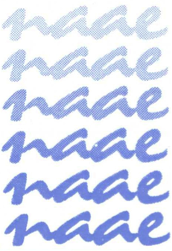The arts in the Early Years Learning Framework
The National Advocates for Arts Education (NAAE) believe that the arts must be included as an essential learning area in the development of the Early Years Learning Framework.
Engagement in the arts provides numerous benefits for learning in these important early years. Basic literacy, numeracy and scientific concepts are introduced through music, movement and visual arts making. Social skills, important for tolerance, understanding and celebration of diversity, are developed through arts experiences such as dramatic play, singing and dancing.
Early participation in the arts can stimulate children’s imagination and creativity (Robinson 2006), supporting the development of the brain’s prefrontal cortex, responsible for planning, self-control, reflection and other aspects of ‘higher thinking’. From the start, rich sensory and active arts experiences are fundamental to healthy growth and aesthetic awareness, as neural science research reveals that the brain’s ‘sensing pathways’ (vision, hearing and touch) are set in the first three years of life (Fraser Mustard 2008).
Daily learning experiences in the visual and performing arts are intrinsic to early childhood pedagogy, supporting individualised learning which is recognised as important for intrinsic motivation and the wide range of learning styles demonstrated by young children (Social Justice In Early Childhood (SJIEC) 2008). Approaches to curricula for early learning draw upon the understanding that young children are active learners and use their bodies as a sensory base for meaning-making (Meiners 2005).
Early childhood professionals have long recognised that the arts offer very young children significant ways of knowing about themselves, others and the world (Edwards 2002; Wright 2003). As babies and toddlers develop spoken language, the arts provide unique ways for them to use movement, images, constructions and sounds along with spoken words, to express themselves, make meaning and communicate ideas and feelings to others (Fowler, Meiners & Orchard 2006).
Children need to be literate in the new skills required for life in the 21st century and, alongside emergent verbal literacy, arts experiences are vital for developing young children’s non-verbal communication. Recent research in the early childhood field has provided much insight and support for a reconceptualised view of literacy as more than words and speech. Children in the early years are multi-literate, processing and interpreting visual images, sound, movement, shape and colour through film, animation and digital images, requiring the use of multi-literacies inherent in different art forms (Livermore 2003; Wright 2003).
Visual, kinaesthetic and musical literacy requires the use of symbolic, non-verbal languages, each with symbols, codes, structure and meanings that provide ways of thinking, expressing ideas and communicating about the world in ways other than writing (Wright 2003). Findings demonstrate that young learners’ competent use of multi-literacies is complex and sophisticated (Healy 2008).
In the early years, children’s engagement in art-making can lead to a stronger sense of harmony with new insights into the human world as they grow up as young citizens in a culturally diverse Australia (Meiners & Schiller 2008). Arts activity in the early years therefore provides opportunities for children to develop embodied visual, kinaesthetic and musical cultural languages, vital for early self expression in 21st century early learning sites which embrace cultural diversity across the nation.
The NAAE therefore requests that the draft Early Years Learning Framework explicitly makes these arguments for the arts in the early childhood years. Unless the arts are mandated in this way, resources will undoubtedly continue to be reduced in an essential area of learning at a vital time of childhood development.
References
Edwards, L. 2002. The creative arts: a process approach for teachers and young children. Merrill Prentice Hall, Upper Saddle River, New Jersey
Fowler, C., Meiners, J. & Orchard, J. (2006). Literacy is more than just words: exploring performance literacy for very young children. Paper presented at the United Nations Educational, Scientific and Cultural Organisation (UNESCO) World Conference on Arts Education: Building Creative Capacities for the 21st century, 6 – 9 March, Lisbon, Portugal
Fraser Mustard, J. 2008. Investing in the early years: Closing the gap between what we know and what we do. Crown – in right of the State of South Australia
Healy, A (ed) 2008, Multiliteracies and diversity in education. New pedagogies for expanding landscapes. Oxford University Press: Melbourne, Australia
Livermore, J. (Ed.) (1998). More than words can say. A view of literacy through the arts. Australia: Australian Centre for Arts Education
Meiners, J. 2005. In the beginning: young children and arts education. In International Journal of Early Childhood, 37 (2), 37 – 44
Meiners, J & Schiller, W 2008. ‘Young children, the arts and culture. In The International Journal of Diversity in Organisations, Communities and Nations, Vol 8. Melbourne, Australia: Common Ground
Robinson, K 2006. Back to Basics: Arts Education in the 21st Century. Keynote Speech. UNESCO World Conference on Arts Education. Lisbon, Portugal, 6 – 9 March
Social Justice In Early Childhood (SJIEC) 2008. Response to Australian Labor Party policies for Early Childhood Education and Child Care Policies
Wright, S. (Ed.) 2003 Children, meaning-making and the arts. Australia: Prentice Hall
